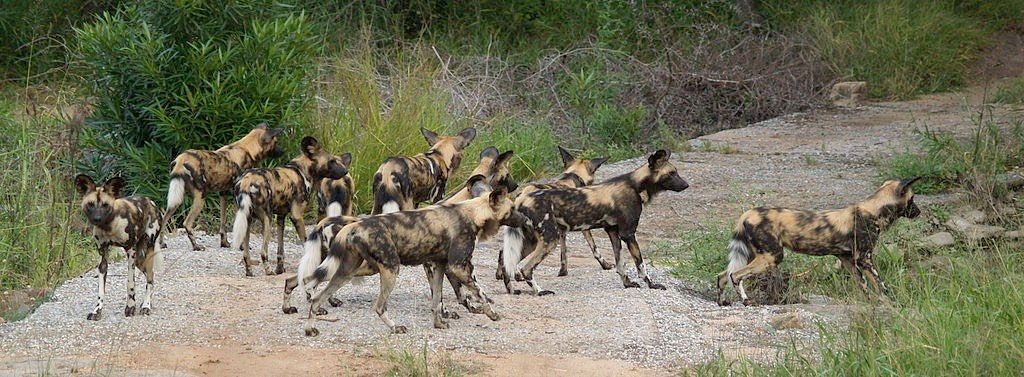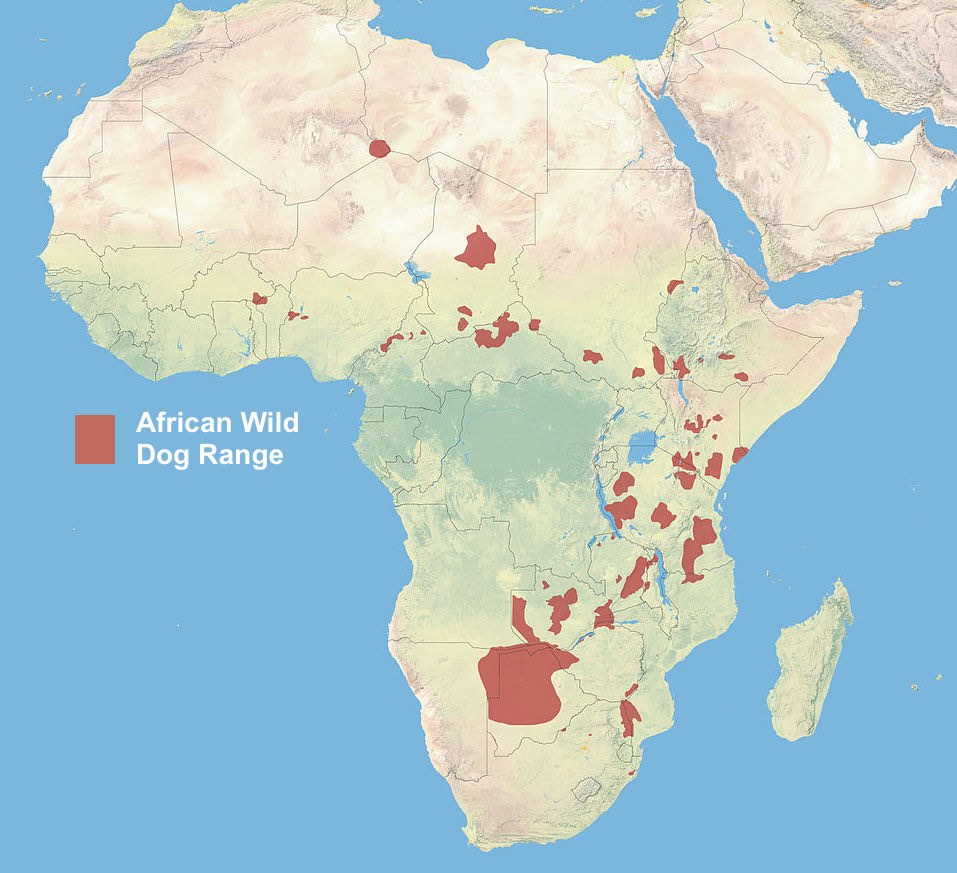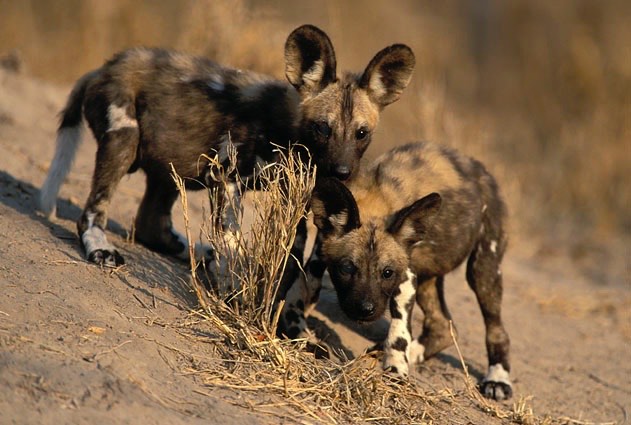Population Ecology
5.1 Africa’s Vanishing Predator The African Wild Dog
Allyson E. Loparo
The African wild dog has become one of the most critically endangered species in Africa. Once nearly 500,000 wild dogs roamed Africa, however now there is only an estimated 3,000 to 5,000. With greatly reduced numbers from the encroachment on farmer and rancher lands, there is a lack of genetic variation and a new strand of canine distemper threatens the species with further decline.

African wild dogs are efficient hunters, with a hunt success rate of almost 80%. This makes them the third most productive hunter in the wild.
Photograph by Bart Swanson, 2007. CC BY-SA 3.0.
The African wild dog, Lycaon pictus, is one of Africa’s premier hunters.1,2 African wild dogs (Figure 1) are one of the top three most efficient hunting animals in Africa and are found on most of the continent aside from the drier deserts in the north, and the denser forests of the southern tip. As some of the most social and vocal animals roaming the earth today, the African wild dog is an essential species to maintaining biodiversity in the African plains, but sadly their numbers are decreasing daily. The African wild dog has been listed as an endangered species since 1990, and the species may soon be listed as critically endangered.3,4,5 The population of African wild dogs was nearly 600,000 two decades ago, but now their numbers have dwindled to fewer than 5,000 individuals (Figure 2).

Modified from Nrg800, 2011. CC BY-SA 3.0.
Lycaon pictus translates directly to “painted wolf” in Greek, which is exactly what the animals resemble.6 No two wild dogs are born with the same coloration and markings, which allows for easy identification by researchers (Figure 3). African wild dogs are the second largest wild canid, other than the grey wolf, and usually weigh between 18-36 kilograms (40-80 pounds) at maturity.6 Males and females are similar in size and shape with males only weighing between 3-7% more than females.6 Their large round ears aid in body heat release and differentiate them from their wolf ancestors.

Photograph by Mosztics Attila, 2008. Public Domain.
One of the major factors contributing to the decline of these animals is their proximity to humans. Humans are responsible for the majority of accidental and intentional deaths of African wild dogs. Some animals are killed accidentally by road accidents or snare trappings, but others are killed to protect livestock and game populations. African wild dogs have learned that corralled animals make easy prey and farmers and ranchers across Africa admit to killing the dogs to protect their assets and livelihood by means of lethal control, such as shooting and the use of poison.7 Since the African wild dog is not on any “no kill” lists, they are legal to kill while on the farmer or rancher’s property. Habitat loss is driving the species away from protected sanctuaries and into private property. In previous years, each dog had on average 130 square kilometers (80 square miles) of hunting territory, but now the wild dogs are down to only 15.6 square kilometers (9.7 square miles).8 African wild dogs need extensive hunting and roaming territory, and most African sanctuaries are not large enough, thus the dogs are forced to go to unprotected areas where they are constantly at risk.7
Packs of mostly related males and a few females create a unique social structure. Packs consist of 10-15 animals and contain females that have not reached breeding maturity.2,9 Females will leave their birth packs near 30 months of age when they reach sexual maturity and search for a pack with insufficient females. This differs from most other pack animals in which females are relatives and the males wander to find packs of females. In a typical pack, the ratio of males to females is 8:1, which contributes to their lack of numbers. Only the alpha female and male will breed once a year to produce 2-19 pups, with an average litter of 104 (Figure 3). At one time, this was an evolutionary advantage to the packs to not strain themselves by having too many pups to take care of at one time. However, now wild dogs are not producing enough offspring to keep up with their declining numbers. Studies have shown that if the alpha female dies, the remaining females in the pack do not always reach sexual maturity, and the pack may split up.
A disease called canine distemper is also ravaging the species (Figure 4). Canine distemper is a viral disease transmitted to other pack mates through aerosol, and it affects the nervous and lymphatic tissues. Research of one pack indicates that none of the members had detectable antibodies to fight canine distemper, which is similar to the human flu but with a mortality rate of 38%.10 Some researchers have begun to vaccinate wild dogs with the same vaccine that we give to domestic dogs to protect against canine distemper, and it has proven to be almost 100% effective.5,9

Courtesy of M. W. Van de Bildt et al., 2002. Public Domain.
The African wild dog is similar to most species in Africa in its need for increased land and reservations for protection. Large hunting ranges force packs out of the reserves, which puts them in contact with the dangers associated with human establishments. Creating more space and increasing the number of park rangers would greatly benefit the survival of many African species of wildlife. Education of farmers and ranchers on the use of non-lethal means to fend off wild dogs, such as higher fences or rubber darts instead of bullets, will aid in increased survival rates for the species. To combat canine distemper, more researchers will need to trap and vaccinate the animals. Also, attaching trackers on to the wild dogs will allow researchers to study hunting ranges and search for a solution to protect the species from accidental and intentional deaths outsides their protected sanctuaries. With the combined efforts of researchers, citizens, farmers, and ranchers the wild dog will recover and thrive in Africa once again.
References
- Davies-Mostert, H.T., et al. (2013). Hard boundaries influence African wild dogs’ diet and prey selection. Journal of Applied Ecology, 50:1358–1366.
- Alexander, K.A., & Appel, M.G. (1994). African Wild Dogs (Lycon-Pictus) Endangered by a Canine-Distemper Epizootic Among Domestic Dogs near the Masai-Mara National Reserve, Kenya. Journal of Wildlife Diseases, 30:81-85.
- Kruger, S.C., et al. (1999). Diet Choice and Capture Success of Wild Dog (Lycaon Pictus) in Hluhluwe-Umfolozi Park, South Africa. Journal of Zoology, 4:543-551.
- Groom, R., et al. (2012). Diet of Four Sympatric Carnivores in Savé Valley Conservancy, Zimbabwe: Implications for Conservation of the African Wild Dog (Lycaon Pictus). South African Journal of Wildlife Research, 42:94-103.
- Woodroffe, R., et al. (2005). Livestock Predation by Endangered African Wild Dogs (Lycaon Pictus) in Northern Kenya. Biological Conservation, 124:225-234.
- Creel, S. (1995). Communal Hunting and Pack Size in African Wild Dogs, Lycaon Pictus. Animal Behaviour, 50:1325-339.
- Marsden, C.D., et al. (2009). Highly Endangered African Wild Dogs (Lycaon Pictus) Lack Variation at the Major Histocompatibility Complex. Journal of Heredity, 100:54-65.
- Davies, H.T., & Du Toit, J.T. (2004). Anthropogenic Factors Affecting Wild Dog Lycaon Pictus Reintroductions: A Case Study in Zimbabwe. Oryx, 38:32-39.
- Carbone, C., et al. (1999). Feeding Success of African Wild Dogs (Lycaon Pictus) in the Serengeti: The Effects of Group Size and Kleptoparasitism. Journal of Zoology, 266:153-161.
- Romañach, S.S., & Lindsey, P.A. (2008). Conservation Implications of Prey Responses to Wild Dogs Lycaon Pictus during the Denning Season on Wildlife Ranches. Animal Conservation, 11:111-117.
- Swanson, Bart. (2007). [Photograph of Wild Dogs in Kruger National Park, South Africa]. Retrieved from Wikimedia Commons. CC BY-SA 3.0.
- Nrg800. (2011). [Diagram of the distribution of the African Wild Dog, according to the IUCN]. Retrieved from Wikimedia Commons. CC BY-SA 3.0. Modifications: Cropped and added key.
- Attila, Mosztics. (2008). [Photograph of African Wild Dog Pups]. Retrieved from Wikimedia Commons. Public Domain.
- Van de Bildt, M.W., et al. (2002). Distemper outbreak and its effect on African wild dog conservation. Emerging Infectious Diseases. 8(2):212-213. Retrieved from Wikimedia Commons. © Center for Disease Control and Prevention. Public Domain.
